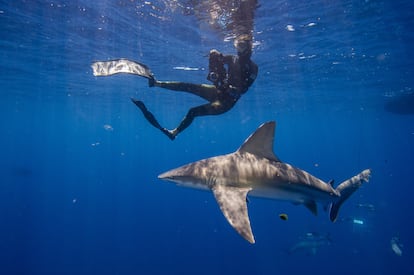The bad luck of Tamayo Perry: The US has had 12 shark attacks so far this year
The state of Florida ranks first in incidents, followed by Hawaii and California. The Florida Museum’s International Shark Attack File lists all known cases and provides advice on how to reduce risks

On June 8, three people were injured by two shark attacks, the first in WaterSound Beach and the second just 3.7 miles away, in Seacrest Beach, in Walton County, in western Florida. One of the victims suffered significant trauma to the pelvic area and his left forearm was amputated, the South Walton Fire District reported. That same day, another woman who was swimming in the water near Oahu’s North Shore, in Hawaii, was bitten by a shark, the Honolulu Department of Emergency Services reported; and this week saw the death of Tamayo Perry, a surfer, instructor, lifeguard and actor in the film Pirates of the Caribbean: On Stranger Tides (2011), also due to a shark attack in the North Shore. This year there have been 24 incidents in the world, as tallied by Tracking Sharks, and 12 in the United States (three in Hawaii, four in Florida, two in California, one in New York and another two in North Carolina).
Although these facts contribute to the perception that these incidents are on the rise, attacks have actually decreased. The Florida Museum, which keeps track, says the odds of being attacked by a shark are one in 11.5 million.
How often do sharks attack?
The Florida Museum’s International Shark Attack File carried out a report in which it listed 69 attacks in 2023. Of these, 36 occurred on the coasts of the United States, with a balance of two fatalities: one in Hawaii and the other one in California. Florida had more attacks than any other state: 16 in total. Last year there was also a 12.2% decrease in shark bites compared to 2022.
The institution also reported that since 1837 there have been 1,632 shark attacks in the United States. The first place again goes to Florida with 928. The reason is none other than the size of its coastlines: 1,350 miles, with locals and tourists enjoying its beaches throughout the year. Those in the know have a nickname for Volusia County, where the popular Daytona Beach is located: “Shark Bite Capital of the World,” with a historical record of 351 cases. Neighboring Brevard and Palm Beach counties come in second and third with 158 and 83, respectively.
Who are the most affected
Surfers suffered the most incidents in 2023, sustaining 42% of attacks. Attacks on swimmers and sunbathers were slightly lower, at 39%. Divers with a tank or lung accounted for 13% of the mishaps.
How sharks usually attack
They almost always attack near the coast. Unlike what you see in the movies, it is not common for victims to see a shark approaching. Most of the time, they don’t bite more than once. They typically employ three attack tactics: hit and run, hit and bite, and sneak attack.
- Hit and run: in most cases a person is mistaken for a different kind of prey. The shark approaches quickly, bites, and then swims away. The wounds are usually small and rarely life-threatening.
- Hit and bite: Sharks surround and hit the victim before attacking. It is the typical attack that scuba divers and divers experience. In this case, the victim may suffer moderate to severe injuries.
- Sneak attack: it is the most dangerous. It starts out similar to the hitting and biting attacks, but this time the shark strikes repeatedly and can be deadly.
How to reduce the risk of being attacked
The International Shark Attack File recommends swimming in company and avoiding the hours of dawn or dusk because the light is poor and this can increase the risk of a shark mistaking a human for other prey. It is also advisable to swim on coasts without fishing activity and not wear shiny jewelry in the water (the sparkles resemble the fish that are prey to sharks). Finally, avoid splashing because it produces a sound similar to that of fish fighting, which can attract the attention of sharks.
Sign up for our weekly newsletter to get more English-language news coverage from EL PAÍS USA Edition
Tu suscripción se está usando en otro dispositivo
¿Quieres añadir otro usuario a tu suscripción?
Si continúas leyendo en este dispositivo, no se podrá leer en el otro.
FlechaTu suscripción se está usando en otro dispositivo y solo puedes acceder a EL PAÍS desde un dispositivo a la vez.
Si quieres compartir tu cuenta, cambia tu suscripción a la modalidad Premium, así podrás añadir otro usuario. Cada uno accederá con su propia cuenta de email, lo que os permitirá personalizar vuestra experiencia en EL PAÍS.
¿Tienes una suscripción de empresa? Accede aquí para contratar más cuentas.
En el caso de no saber quién está usando tu cuenta, te recomendamos cambiar tu contraseña aquí.
Si decides continuar compartiendo tu cuenta, este mensaje se mostrará en tu dispositivo y en el de la otra persona que está usando tu cuenta de forma indefinida, afectando a tu experiencia de lectura. Puedes consultar aquí los términos y condiciones de la suscripción digital.
More information
Archived In
Últimas noticias
A survivor’s account of the Interoceanic Train accident: ‘We were scared because of the speed on the curve’
The Interoceanic Train, the Mexican alternative to the Panama Canal
What is known about the Interoceanic Train derailment in Oaxaca
Trump turns a Minnesota fraud allegation into ammunition for his MAGA army against Democrats
Most viewed
- Oona Chaplin: ‘I told James Cameron that I was living in a treehouse and starting a permaculture project with a friend’
- Reinhard Genzel, Nobel laureate in physics: ‘One-minute videos will never give you the truth’
- Why the price of coffee has skyrocketed: from Brazilian plantations to specialty coffee houses
- Pablo Escobar’s hippos: A serious environmental problem, 40 years on
- Chevy Chase, the beloved comedian who was a monster off camera: ‘Not everyone hated him, just the people who’ve worked with him’











































